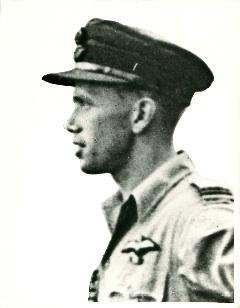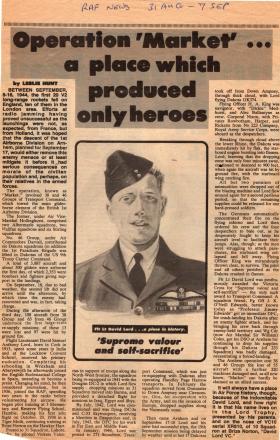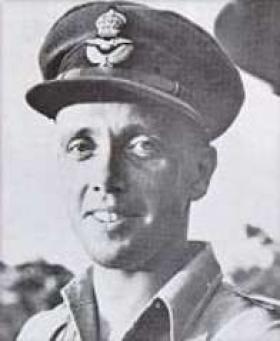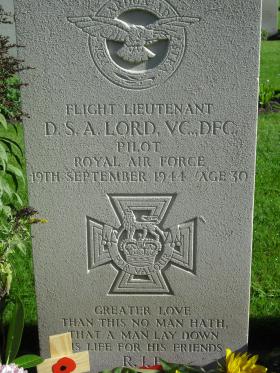David ‘Lummee’ Samuel Anthony Lord, VC, DFC, MiD (18 October 1913 – 19 September 1944) was a posthumous recipient of the Victoria Cross for his actions while flying resupply missions in support of British airborne forces during the Battle of Arnhem: he was the only member of the Royal Air Force Transport Command to be awarded the Victoria Cross during the Second World War.
Lord, born in Cork (Ireland) later moved with his family to Wrexham and enlisted in the Royal Air Force on 6 August 1936 after abandoning training as a priest. After reaching the rank of Corporal in August 1938, he applied to undertake pilot training, which he began in October 1938. Successfully gaining his pilot's wings, he became a sergeant pilot in April 1939, and was posted to No. 31 Squadron RAF, based in Lahore, India. He later flew the Vickers Valentia biplane transport. In 1941, No. 31 Squadron was the first unit to receive the Douglas DC-2 which was followed by both the Douglas DC-3 and Dakota transports. That year he was promoted to flight sergeant and then warrant officer. He flew in North Africa, supporting troops in Libya and Egypt for four months, before being posted back to India: he was notably shot down by three Messerschmitt 109’s in North Africa, his actions there leading to him being awarded the DFC. Commissioned as a pilot officer in May 1942, he flew supply missions on the extremely hazardous India-Burma-China’ ‘supply route known as ‘the hump’, for which he was mentioned in despatches.
Lord was awarded the Distinguished Flying Cross in July 1943, receiving the award at Buckingham Palace, and was promoted to Flight Lieutenant shortly afterwards. By January 1944, he had joined No. 271 Squadron (based at RAF Down Ampney, Gloucestershire) and began training as part of preparations for the invasion of Europe. On D-Day, Lord carried paratroopers into France and his aircraft was hit by flak, returning to base without flaps.
Lord was 30 years old, and a Flight Lieutenant serving with No. 271 Squadron, Royal Air Force during the Second World War when he was posthumously awarded the Victoria Cross for actions on September 19 ,1944. Lord had already participated in a glider release earlier in operation Market Garden when he was then tasked to fly one of the 17 aircraft from 271 Squadron on a re-supply operation on 19 November. 271 Squadron’s drop zone was DZ "V". Unfortunately, the Germans had established the position of the drop zone and set up a trap consisting of 4 x 20mm guns and at least one 88mm battery. In the afternoon, several Short Stirling aircraft were shot down and despite an attempt to communicate information about the presence of the German forces, it did not arrive in time. Seventeen Dakotas, the last aircraft to arrive at the drop zone, were met by fierce anti-aircraft fire. Allied troops were in direct contact with the enemy around the drop zone. Short of parachutes, wickerwork freefall baskets were used to drop non-breakable or non-explosive supplies, and aircrews were briefed to fly in at 500 feet at 120 mph in a straight line for two minutes, in broad daylight, without a fighter escort. Aircraft no. KG374, the Dakota (Douglas Dakota Mk.III, the Royal Air Force designation for the US Army Air Forces’ Douglas C-47A Skytrain) piloted by David Lord, was hit by flak twice 4 miles from the drop zone and its right wing set ablaze. Lord continued towards the drop zone despite the risk of a structural wing failure due to a fuel tank/engine fire. After the initial drop two containers of ammunition remained on board because the container roller system had been damaged by flak, and despite the certainty that his aircraft would crash, Lord and his crew circled round and made another pass over the drop zone while under enemy fire: this took an estimated eight minutes. With its wing ablaze it was reported that many on the ground stopped fighting and looked on in awe at the spectacle of bravery: Major General Roy Urquhart remembered looking on "spellbound and speechless" as the burning aircraft flew through a blizzard of fire not just once but twice in order to complete its mission. He later wrote: "I dare say there is not a survivor of Arnhem who will ever forget, or want to forget, the courage we were privileged to witness in those terrible eight minutes." David Lord shouted to his crew to jump, but the wing failed before they had time to escape and the aircraft crashed in flames. Of the six crew and army air dispatchers only the ‘stand in’ navigator, Flying Officer Henry A. King, survived as he was thrown out as the wing broke off, witnesses on the ground reporting that his parachute only just opened in time, and he became a prisoner of war. King spent the remainder of the war at Stalag Luft I. It was only on his release in mid-1945, and reports from members of the 10th Parachute Battalion who had also been POW’s, that led to the story of Lord's action becoming known. Lord was awarded a posthumous Victoria Cross and his crew awarded either were awarded the Military Cross or Military Medal.
Crew: David Lord (pilot), Henry King(navigator), 19-year-old Richard Medhurst ( Co-pilot), 'Alec' Ballantyne (wireless operator), and a four-strong team of army despatchers from the RASC, Corporal Phil Nixon, Drivers Len Harper, James Ricketts, and Arthur Rowbotham, whose job was to ensure the smooth release of their cargo of eight panniers of ammunition.
Lord’s VC citation differs to the account given by Henry King in as much as King believed they were flying much lower.
The full citation for Lord's VC appeared in a supplement to The London Gazette on 9 November 1945, and read:
‘Air Ministry, 13 November 1945.
The KING has been graciously pleased to confer the VICTORIA CROSS on the undermentioned officer in recognition of most conspicuous bravery:—
Flight Lieutenant David Samuel Anthony LORD, DFC. (49149), RAF, 271 Sqn. (deceased).
Flight Lieutenant Lord was pilot and captain of a Dakota aircraft detailed to drop supplies at Arnhem on the afternoon of 19 September 1944. Our airborne troops had been surrounded and were being pressed into a small area defended by a large number of anti-aircraft guns. Air crews were warned that intense opposition would be met over the dropping zone. To ensure accuracy they were ordered to fly at 900 feet when dropping their containers.
While flying at 1,500 feet near Arnhem the starboard wing of Flight Lieutenant Lord's aircraft was twice hit by anti-aircraft fire. The starboard engine was set on fire. He would have been justified in leaving the main stream of supply aircraft and continuing at the same height or even abandoning his aircraft. But on learning that his crew were uninjured and that the dropping zone would be reached in three minutes he said he would complete his mission, as the troops were in dire need of supplies.
By now the starboard engine was burning furiously. Flight Lieutenant Lord came down to 900 feet, where he was singled out for the concentrated fire of all the anti-aircraft guns. On reaching the dropping zone he kept the aircraft on a straight, and level course while supplies were dropped. At the end of the run, he was told that two containers remained.
Although he must have known that the collapse of the starboard wing could not be long delayed, Flight Lieutenant Lord circled, rejoined the stream of aircraft and made a second run to drop the remaining supplies. This manoeuvre took eight minutes in all, the aircraft being continuously under heavy anti-aircraft fire.
His task completed, Flight Lieutenant Lord ordered his crew to abandon the Dakota, making no attempt himself to leave the aircraft, which was down to 500 feet. A few seconds later, the starboard wing collapsed and the aircraft fell in flames. There was only one survivor, who was flung out while assisting other members of the crew to put on their parachutes.
By continuing his mission in a damaged and burning aircraft, descending to drop the supplies accurately, returning to the dropping zone a second time and, finally, remaining at the controls to give his crew a chance of escape, Flight Lieutenant Lord displayed supreme valour and self-sacrifice’.
After Arnhem was liberated in April 1945, Grave Registration Units of the British 2nd Army moved into the area and began to locate the Allied dead. Lord was re-buried alongside his crew in the Arnhem Oosterbeek War Cemetery. There are many plaques in memory of him, including one at Wrexham Cathedral in Wales.
Lord's Victoria Cross was presented to his parents at Buckingham Palace in December 1945. As of 2014, the medal group is on display at the Imperial War Museum [Lord Ashcroft Collection].
The actions of Lord and his crew have been commemorated by the market Garden Foundation in the Netherlands, and in 2019 his niece Lucinda Lord was present when a memorial was unveiled. The unveiling was also attended by Glider Pilot and Arnhem veteran Ron Johnson, who witnessed the crash of Lord's aircraft and knew Lord from their time at Down Ampney airfield.
The Dakota at the entrance to Merville Barracks has the markings of Lord’s aircraft.
John Beales Researcher at Collective Media Group.
Read More




Latest Comments
There are currently no comments for this content.
Add Comment
In order to add comments you must be registered with ParaData.
If you are currently a ParaData member please login.
If you are not currently a ParaData member but wish to get involved please register.